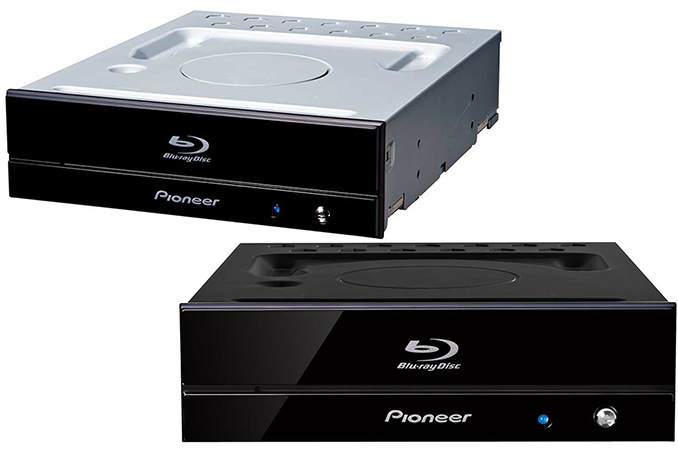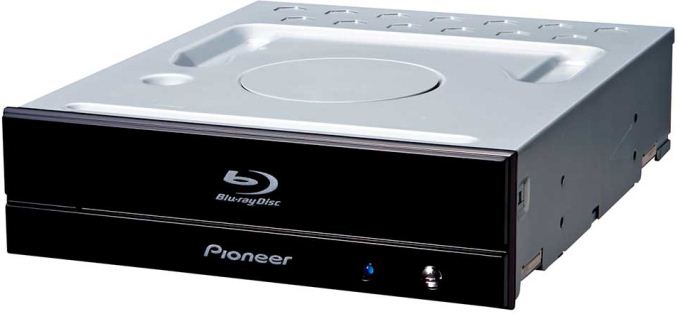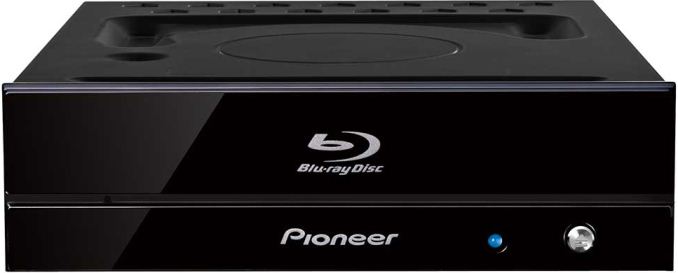Pioneer Announces Ultra HD Blu-ray Supporting BDR-S11J Drives
by Anton Shilov on January 26, 2017 4:25 AM EST- Posted in
- Optical Media
- 4K
- UHD
- ODDs
- Pioneer
- Ultra HD Blu-ray

Pioneer has announced its first Blu-ray disc burners that officially support playback of Ultra HD Blu-ray discs. The drives will be Pioneer’s top-of-the-range ODDs and will thus support all the latest technologies from the company, but it is important to note that Ultra HD Blu-ray discs have a number of specific requirements and despite formal support for the latest media format, the drives will not transform any PC into a UHD BD player alone due to the numerous requirements (something that system integrators will have to ensure).
The New Drives
The Pioneer BDR-S11J-BK and the BDR-S11J-X are advanced optical disc drives in a 5.25” form-factor with the SATA 3.0 interface capable of reading and recording CD (CD, CD-R, CD-RW), DVD (DVD, DVD±R, DVD±R DL, DVD±RW, DVD-RAM) and Blu-ray (BD, BD-R SL/DL/TL/QL, BD-RE SL/DL/TL, BD-R LTH) discs. The drives have 4 MB buffer underrun protection (which is in line with other higher-end ODDs from competitors) and support 16x burning speed for BD-R SL (25 GB) media. Meanwhile, writing capabilities are not the key feature of the new ODDs. Pioneer advertises improved CD audio playback as well as support for Ultra HD Blu-ray discs as the key selling points of the new drives by way of updated technologies.
Usage of optical discs has been declining in the recent years, but those people who still use ODDs tend to demand features like fine reading/playback of scratched discs in general and audio CDs in particular (simply because they have large collections of appropriate media). To appeal to these people, the Pioneer BDR-S11J-BK and the BDR-S11J-X support the PureRead 4+ and Real Time PureRead functions specifically tailored to improve reading performance of scratched audio CDs. In addition, the more expensive BDR-S11J-X has further enhancements to improve playback quality of inserted audio CDs. Pioneer does not reveal too many details other than saying about finely tuned internal components (possibly to minimize vibration) as well as a feature called the “playback quality check.”
Another important capability of the Pioneer BDR-S11J-BK and the BDR-S11J-X ODDs is guaranteed support for Ultra HD Blu-ray discs. Technically speaking, to read a 100 GB Ultra HD Blu-ray disc, an ODD must support triple-layer Blu-ray disc with 33 GB layers and up to 128 Mbps data rate (i.e., 4x read speed). Therefore, any BDXL-supporting BD ODD has technical capabilities to read UHD BDs. However, not everything is that simple.
New Requirements for Ultra HD Blu-ray Video Playback
Meanwhile, to actually playback an Ultra HD Blu-ray disc, users will need:
- A PC that supports AACS 2.0 and Intel Software Guard Extensions (SGX)
- An appropriate optical disk drive,
- Software that handles UHD BD playback,
- Windows 10,
- A GPU that has an HDMI 2.0a output with HDCP 2.2 (and AACS2 supported by its driver, which eliminates current-gen standalone GPUs) and,
- A 4K TV/display that has an HDMI 2.0a input with HDCP 2.2.
While there are graphics adapters that support HDCP 2.2, as well as displays that also support it, at the time of writing there are no software packages that support playback of Ultra HD Blu-ray discs. CyberLink last year promised to update its PowerDVD 16 Ultra to support UHD BDs, but so far, this feature has not been formally added to the player. Now, while many contemporary BDXL-supporting ODDs can read Ultra HD Blu-ray discs (and allow users to browse files or write to them), manufacturers tend not to declare UHD BD playback support by their products. While it is possible that this is a software limitation, it is also possible that the limitation is hardware and currently available optical drives miss an important piece or two required to playback UHD BD movies even once appropriate software is available and they are installed into qualifying PCs. That said, Pioneer is currently the only ODD supplier that formally declares support for UHD BDs, at least in terms of files.
Apart from the ODD, the GPU (and its driver), the display, and the playback software, AACS 2.0 support seems to be a major concern. Its implementation on the PC is different from other consumer electronics, according to CyberLink. In a bid not to let AACS 2.0 encryption keys leak (as it happened in the past to the original AACS), AACS LA demands to handle their decryption in a secure hardware environment. To create secured private regions of memory that cannot be accessed by third-party applications (to prevent access to AACS2 keys), software developers have to use Intel’s Software Guard Extensions (SGX) instructions, whereas end users have to use platforms featuring the technology. Intel’s SGX has to be supported by the CPU, the OS and the application, but one of the problems is that not all modern processors support it. Intel first incorporated SGX into its Skylake CPUs in 2015, but not all of such chips support the tech: for example, some of the early higher-end processors have it disabled. Moreover, SGX has to be supported by motherboard’s BIOS and at present Pioneer recommends Intel 200-series based platforms (note that this does not mean that every Intel 200-series mainboard supports SGX). It is also important to note that not every Intel 200-series motherboard/system supports HDCP 2.2, which is required if the integrated is used. In fact, in the latter case Pioneer says that Intel’s HD Graphics 630 or more advanced is required, which eliminates low-power CPUs.
One of the peculiarities of playback via AACS2 is that it has to be supported by the whole system, not just certain critical components. This may not be a big problem for consumer electronics (even though it has its peculiarities there as well, for example, a requirement to pair a drive with its host that binds them at time of manufacture that will make lives of people who rip disks harder, but will also make it impossible to replace a failed ODD in a player), but for PCs things are going to get considerably more complicated. The content has to be encrypted using AACS2 throughout the whole data transfer from the optical disc to the decoder (i.e., the GPU for a PC) and then decoded in a secure environment. Since AACS2 mandates the use of secure environment at all times, decryption of Ultra HD Blu-ray content in a PC is now possible only on an iGPU that uses system memory with appropriate regions set aside for this particular task. Unless companies like AMD and NVIDIA invent their own SGX-like technology or manage to support Intel’s extensions in their drivers and by their discrete hardware, it will not be possible to use standalone GPUs for Ultra HD Blu-ray playback despite all their advanced media decoding capabilities. Quite naturally, this leaves systems based on Intel’s multi-core Core i7 HEDT processors without Ultra HD Blu-ray encoded playback content, but that is a price that PCs have to pay for AACS2.
Pioneer will bundle various programs with the BDR-S11J-BK and the BDR-S11J-X ODDs, including CyberLink’s PowerDVD 14 (not quite new), PowerDirector 14, PowerProducer 5.5, Power 2 Go 8, InstantBurn 5 and so on. The manufacturer did not reveal the official price of the new drives, but PC Watch reports that the BDR-S11J-BK and BDR-S11J-X will be priced at ¥22,000 ($193) and ¥35,000 yen ($307) respectively when they are available in Japan in late February.













64 Comments
View All Comments
Gich - Thursday, January 26, 2017 - link
I was waiting for this... but not like this...Nevermind... I'll just get an Xbox One S.
Alexvrb - Thursday, January 26, 2017 - link
Agreed. I was considering getting a UHD BD drive for my next PC build just to have - not anymore. I mean heck even if I carefully pick components that are all compliant, the price of the drive alone is enough to make me balk.chrcoluk - Friday, January 27, 2017 - link
I have a dvd burner in my main rig, the only use its got is a few dvd's I purchased of some content thats in dvd format only, and that is it, probably used it 2 or 3 times ot play such content in the past 2 years. I definitely never burn anything anymore. My laptop also has one integrated. If my dvd burner died I wouldnt replace it as I have the laptop, not to mention my ps3, ps4 and xbox260 zll have optical playback devices, however if I really had to get a new optical unit I would probably just buy a cheap external usb unit for situational use.Now days usb sticks have took over the role for things like OS installation and portable storage, and if I find I run out of hdd space to store stuff, I tend to just upgrade my hdd space.
Bullwinkle J Moose - Thursday, January 26, 2017 - link
"at the time of writing there are no software packages that support playback of Ultra HD Blu-ray discs"and here is why >
to actually playback an Ultra HD Blu-ray disc, users will need:
A PC that supports AACS 2.0 and Intel Software Guard Extensions (SGX)
An appropriate optical disk drive,
Software that handles UHD BD playback,
Windows 10,
A GPU that has an HDMI 2.0a output with HDCP 2.2 (and AACS2 supported by its driver, which eliminates current-gen standalone GPUs) and,
A 4K TV/display that has an HDMI 2.0a input with HDCP 2.2.
------------------------------------------------------------------------------------
OR, I can Burn NON-DRM 4K Videos to a NON DRM Nightmare RIGHT NOW and do it in Windows XP/7/8 or 10!
Great Job Guys....
I'd rather buy a mini Blu-Ray Burner as a floppy disk replacement
I could store an Acronis bootable backup of every OS listed above with room to spare for mandatory software in a single triple layer disk and never worry about malware encrypting my Read Only backups but Oooooh, thats right, they cancelled all their mini-disk production
B.T.W.
BD-RE is equivalent to DVD+R for anyone interested in making backups to a bootable rewritable disk and work fine even in Windows XP
Gothmoth - Thursday, January 26, 2017 - link
i don´t get what you are saying.. sorry.Bullwinkle J Moose - Thursday, January 26, 2017 - link
"i don´t get what you are saying"------------------------------------------
Just saying I'd rather have a high density 80cm "mini disk" reader/writer
There are still valid reasons for Read Only Media without DRM hoops to jump through for disks I will never buy
I'd rather put critical backups on an Optical Disk rated to last 1000 years like an M-Disk or rewritable boot disk instead of copying them to an SSD or hard drive that is about to get hit by a malware attack
....and who the He^^ puts critical backups in the Clouds anyway?
close - Thursday, January 26, 2017 - link
Ah... M-Disc, the media that's barely been on the market for ~6-7 years, claims to last 1000 years but everything that would validate the claim is a trade secret so best you can do is put your data on one and wait.Meanwhile plenty of independent testing showed that under not so ordinary conditions (probably unnaturally hot/humid conditions) they are no more resilient than DVDs. Also only a handful of units can burn M-Disc and 4.7GB blanks are more expensive (by a good margin) than 25GB BD-R blanks. But they last 1 (one) gazillion years, scout's honor.
What if the malware gets written on the M-Disc, what do you do then? That's 1000 years of malware that you can't get rid of.
Bullwinkle J Moose - Thursday, January 26, 2017 - link
"What if the malware gets written on the M-Disc, what do you do then? That's 1000 years of malware that you can't get rid of."--------------------------------------------
Well, I've broken hundreds of malware infected CD's and DVD's in my lifetime, let's see if I can break a malware infected Blu-Ray disk
Yup, not a problem!
Antiviruses are the first thing disabled by malware in your operating system
You might want to try storing clean antivirus rescue disks on...........Read Only DVD!
I recheck older optical disks every few years for malware when the antivirus signatures had a chance to catch up, and break the bad optical disks after saving the crap I want to keep on a freshly wiped hard drive
I use a READ ONLY operating system to save the NON-infected data and rescan the hard drive after a reboot to clean temporary infections from the READ ONLY operating system
THEN, I burn a new disk without the malware being saved for 1000 years
A Read Only installation of Windows XP is the OS I use when cleaning infected optical disks.....
Driveshield works great for making it READ ONLY!
What do YOU use, and how do YOU prevent rootkits that disable your antivirus first withoout your knowledge and that you will never find unless you scan your boot drive with a READ ONLY rescue disk?
Bullwinkle J Moose - Thursday, January 26, 2017 - link
Please don't tell me you use Windows 10....Windows 10 IS the malware!
Microsoft is not allowed to use DRM on MY systems unless I can force them to use MY DRM on their systems!
Forcing Weaponized spyware and malware onto all modern Windows systems and calling it DRM is the problem, not the solution
If security experts are not allowed to remove DRM malware that opens backdoors for every hacker on the planet, then how can you ever secure your system?
They have made it a crime for you to secure your own system and close the backdoors yet they tell you that YOU cannot do the same thing to THEM to prevent the theft of YOUR data
When it becomes a crime to stop the criminals, something is VERY wrong
Plus, you get to pay for your own enslavement!
On topic and to the point....
close - Friday, January 27, 2017 - link
No, antiviruses are the first thing disabled by malware on YOUR operating system (you're on XP SP2, right?). I haven't had malware on any of my systems in well over 15 years. Unless it's of the NSA variety :).And if you can just break the 1000 year media don't you... lose data? You know you don't break just the malware bits don't you? What do you do when you discover your 1 year old data is malware ridden, go back in time before the infection and rewrite it on a disk? Being stuck with malware for 1000 years or having to personally kill your data, that can keep you up at night.
Come on, if you can't protect your data on a backup HDD you won't on an M-Disc either. You'll lose data just the same. Also you'll lose money since you pay for a 4.7GB M-Disc 50% more than on a 25GB BD-R (~60-80c/GB judging by today's market prices).
I once was like you. I used to tell the proctologist that he can't finger my butthole unless I can finger his. I called it enslavement, I called him a criminal, all it got me was a stint in the loony bin with a guy who was dressing as a toy elk or something... Oh wait... ;)